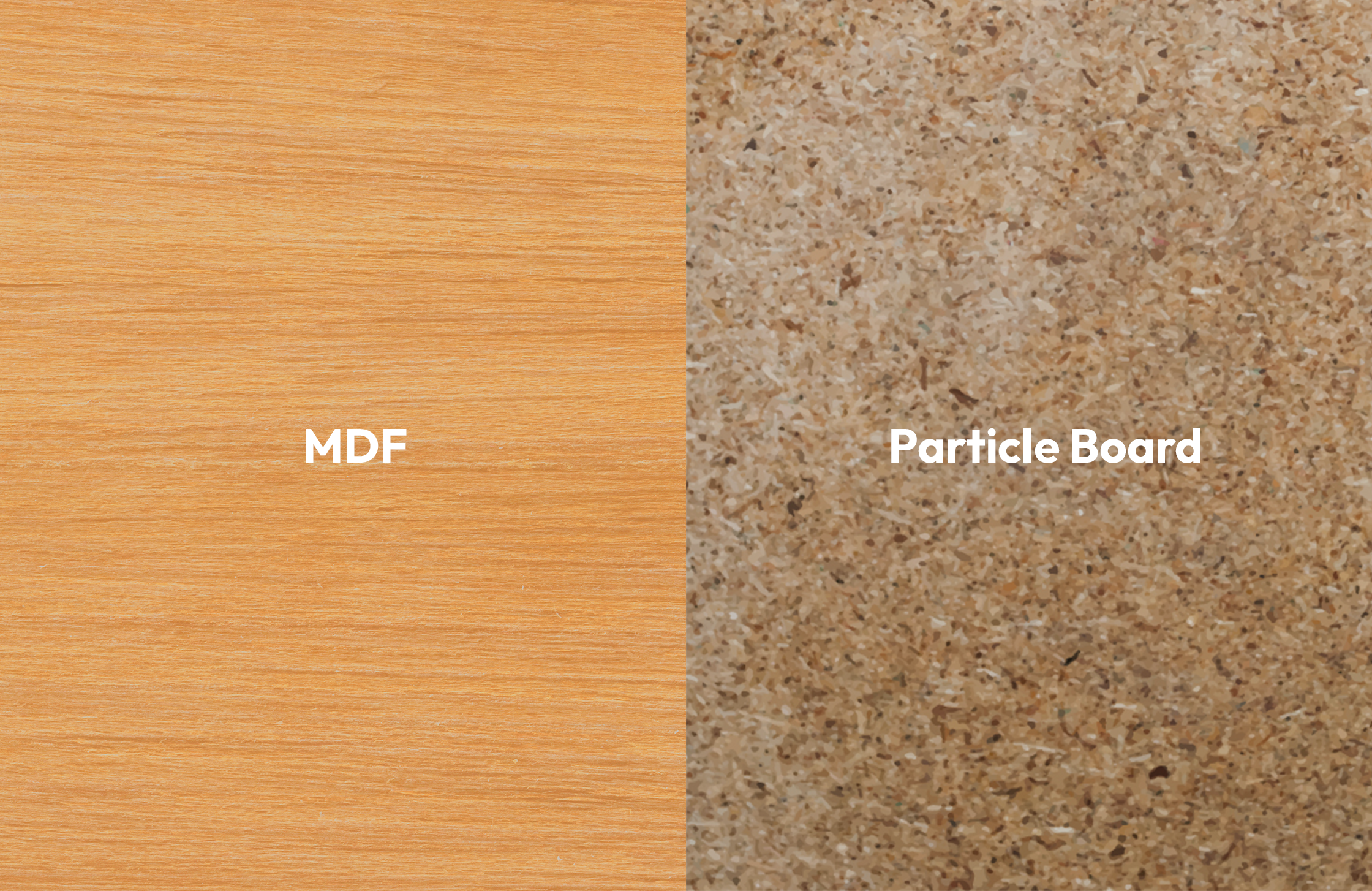Here’s a comparison between MDF (Medium-Density Fiberboard) and particle board, two popular types of engineered wood often used in furniture, cabinetry, and construction.
MDF (Medium-Density Fiberboard)
What is MDF?
MDF is an engineered wood product made by compressing small wood fibers with wax and resin under high pressure and heat. It has a smooth, dense surface and is often used as a substrate for veneers, laminates, or paint finishes.
Pros of MDF:
1. Smooth Surface: MDF has a consistent, smooth surface that’s ideal for painting and laminating. It doesn’t have knots or grain, giving it a sleek finish.
2. Durability: MDF is denser and stronger than particle board, which makes it more durable and less prone to cracking or warping.
3. Better Screw Holding: MDF holds screws better than particle board, especially when using longer screws, making it suitable for applications that require stability.
4. Easier to Shape: MDF is easier to cut, shape, and machine, allowing for detailed designs and applications like molding or routed edges.
Cons of MDF:
1. Heavy: MDF is heavier than particle board, which can make it harder to handle and transport.
2. Moisture Sensitivity: MDF is highly susceptible to moisture damage, and exposure to water can cause it to swell or warp. Sealing the edges and using a waterproof finish is essential in humid environments.
3. Potential for Off-Gassing: MDF can release formaldehyde, a chemical used in its production. This off-gassing may be a concern in enclosed spaces.
Best Uses for MDF:
MDF is ideal for indoor furniture, cabinets, shelves, wall paneling, and decorative moldings. Its smooth surface and ease of shaping make it a popular choice for painted finishes.
Particle Board
What is Particle Board?
Particle board is made by pressing and binding small wood chips, sawdust, and resin. It has a less dense structure compared to MDF and is generally cheaper and lighter.
Pros of Particle Board:
1. Affordability: Particle board is often the most affordable type of engineered wood, making it a budget-friendly choice for furniture and cabinetry.
2. Lightweight: It’s lighter than MDF, making it easier to transport and handle, which can be useful for certain types of furniture.
3. Availability: Particle board is widely available and often used in ready-to-assemble furniture due to its cost-effectiveness.
Cons of Particle Board:
1. Lower Durability: Particle board is not as strong as MDF, which makes it more susceptible to cracking, breaking, or sagging under heavy loads.
2. Weak Screw Holding: Particle board doesn’t hold screws as well as MDF, which can limit its use in applications where stability is essential.
3. Prone to Moisture Damage: Like MDF, particle board is vulnerable to moisture. However, it tends to swell and crumble faster than MDF when exposed to water, making it less ideal for humid areas.
Best Uses for Particle Board:
Particle board is often used in budget-friendly furniture, underlayment, countertops, and shelving that won’t be exposed to heavy loads or moisture. It’s commonly found in low-cost, flat-pack furniture.
MDF vs. Particle Board: Key Differences
1. Strength and Durability:
• MDF is stronger, denser, and more durable than particle board, making it a better choice for furniture that needs to withstand daily use.
• Particle board is more prone to sagging, chipping, and damage under heavy loads, so it’s generally used for lighter-duty furniture.
2. Surface Finish:
• MDF has a smooth, consistent surface that’s ideal for painting and laminating.
• Particle board has a rougher texture and may require veneers or laminates to improve its appearance.
3. Screw Holding Capacity:
• MDF can hold screws better than particle board, allowing it to be used in more structural applications.
• Particle board’s loose structure means it doesn’t hold screws as well, and frequent reassembly can cause screws to loosen.
4. Cost:
• MDF is generally more expensive than particle board due to its durability and density.
• Particle board’s affordability makes it a popular choice for budget furniture.
5. Moisture Resistance:
• Both MDF and particle board are susceptible to moisture, but particle board tends to be more prone to swelling and disintegration when exposed to water.
• MDF performs slightly better with proper sealing but is also best kept away from high-moisture environments.
Conclusion: MDF or Particle Board?
• Choose MDF if you need a smooth, strong, and durable surface that can be painted or laminated. MDF is ideal for projects that require shaping and a high-quality finish, such as cabinetry, wall paneling, or indoor furniture.
• Choose Particle Board if you’re working on a budget-friendly project that doesn’t require heavy-duty strength, like lightweight furniture, shelving, or flat-pack items. It’s a practical choice for short-term or lower-cost needs.
Ultimately, your choice between MDF and particle board will depend on your budget, durability requirements, and intended use. Both materials have their strengths and limitations, so it’s essential to consider what matters most for your specific project.


Share:
Top 7 Common Standing Desk Problems and How to Fix Them for a Better Workspaces